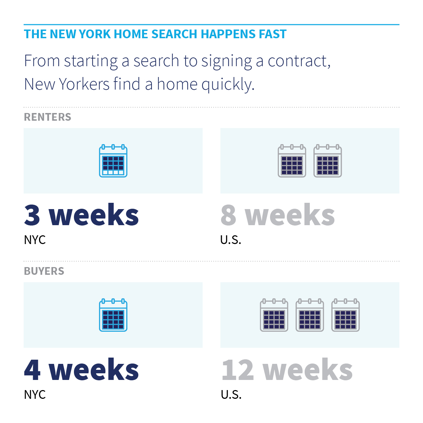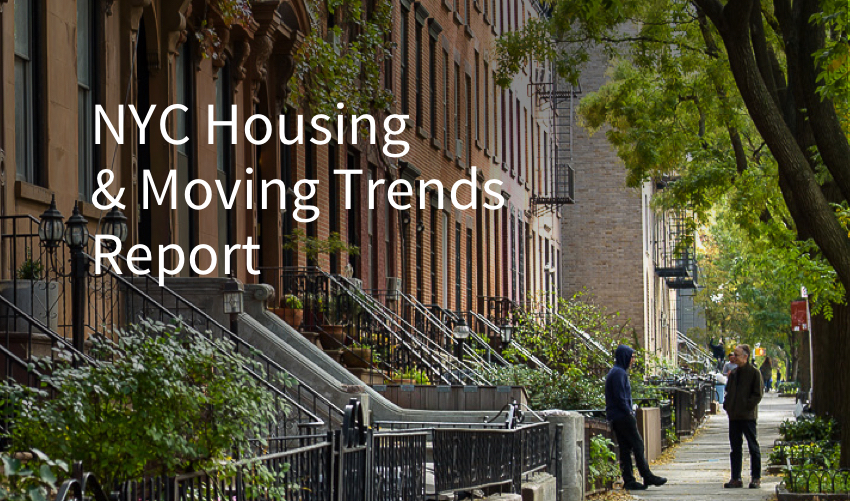
Affording the Unaffordable: Perception vs. Reality in NYC Housing Costs, and Why New Yorkers Move
Key Findings:
- 57 percent of New Yorkers would recommend life in NYC, particularly millennials and homeowners.
- There is a dissonance in the perception of New York housing costs: Nearly 1 in 2 think New York is unaffordable, yet few feel that way about their own home.
- Despite rising housing costs, more than 1 in 3 plan to move in the next year. Most residents are considering moving neighborhoods; few are considering leaving their borough.
- Millennials are most likely to exceed their budget for housing in NYC. They’re also the most likely to consider purchasing a home in the next year.
- New Yorkers prioritize safety and access to public transportation in a neighborhood, and price and space in a home. Luxury amenities like doormen and in-building gyms have no impact on most New Yorkers’ choice of homes.
- More than 1 in 3 New Yorkers cite the high cost of living as a top reason they would leave; the desire for a bigger home and home ownership also rank highly.
Introduction
New Yorkers are a unique group of Americans, and the economic engine of New York City is one of the nation’s greatest assets. The New York metro area accounts for nearly 9 percent of all goods and services produced in the United States, the largest share of any metro area.[1] Moreover, it’s growing: Since the end of the last recession, New York’s private sector has created an average of 23,500 new jobs per quarter and grown 2.7 percent per year, faster than the national rate of 2.0 percent.[2]
The residents of New York City play a key role in driving the nation’s economic growth — but housing the more than 8 million people that run this engine presents a tremendous challenge. To get a more complete picture of how New Yorkers fare in such a dynamic but geographically constrained metropolis, StreetEasy surveyed 1,000 residents across all five boroughs about their experience in the city, what they care about most in a home, and their perceptions on livability and affordability. This New York City Housing and Moving Trends Report reviews our survey findings in the context of the city’s ever-changing demographic and economic environment.
How New York Housing Is Different
New Yorkers stand apart from other Americans: They are younger (the median age is 36, versus 38 for the country), more diverse (43 percent identify as white, compared to 73 percent of the country), and more educated (37 percent have a bachelor’s degree, compared to 31 percent of Americans). While the $55,000 annual median income in New York City is in line with the national average, Manhattanites and Staten Islanders earn a higher median income of $75,000 per year. Education also pays better here: New Yorkers with bachelor’s and master’s degrees earn about $8,000 and $6,000 more per year than the national median, respectively.
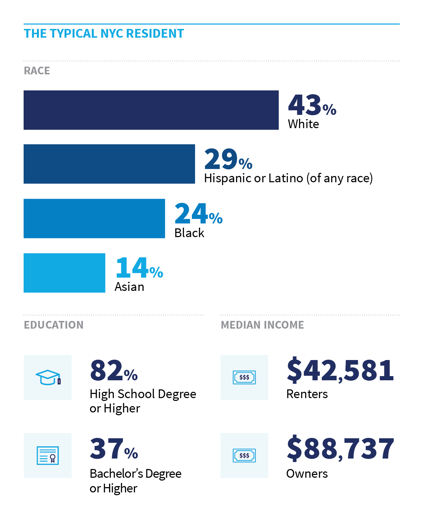
Housing such a diverse group across a series of small islands is not easy or cheap, and New Yorkers pay 1.3 times more for housing in absolute terms than average Americans. According to the U.S. Census, median rent is higher in New York than in the country as a whole, though it’s roughly in line with major cities like Boston and San Francisco. However, median rents as reported by the Census vary widely across boroughs, from $1,100 in the Bronx to almost $1,600 in Manhattan. Taking mortgages, rents, and real estate taxes into account, median monthly housing costs accumulate to an average of $1,360 for each household in the New York City, compared to $1,000 nationally.
The high cost of housing means that New Yorkers go to unique lengths to afford life in the city. New Yorkers are both more likely to rent and to take on roommates than residents of other major American cities, including Boston, San Francisco, Los Angeles, Washington D.C., and Chicago. More than 68 percent of households in New York rent their homes, a stark contrast with a country in which only 36 percent of households rent.[3] Most New Yorkers — 72 percent — have spouses, partners, or roommates with whom they share the burden of rent, compared to 66 percent nationally.[4]
New Yorkers tend to be higher earners than their counterparts across the country when taking their housing choices into account: Renters in New York earn more than renters across the country; owners in New York tend to earn far more than owners across the country. Median household incomes for New York renters and homeowners are around $43,000 and $89,000, respectively, compared to the national median incomes of $35,000 for renters and $71,000 for homeowners.[5] Thus, many New Yorkers are rich relative to the rest of the country, and pay a high premium to live here.
New Yorkers Struggle to Stay Within Their Budget
New Yorkers have a strong bond with their city, home, and neighborhood, and they savor the opportunities that life in the city offers. Unsurprisingly, however, our survey found that the affordability of homes in the city worries many, especially those who experienced the rapid rise in home prices and rents over the last two decades.
Nearly one in three New Yorkers (31 percent) exceeded their initial budget when purchasing or renting their current residence. Home buyers, facing the complicated requirements of a down payment, a mortgage, and various taxes and fees, are more likely to overspend: 37 percent of them went over their initial budget, compared to just 27 percent of renters.
Millennials are more likely than any other generation to go over budget, with 45 percent choosing a pricier home than they’d planned on, compared to 30 percent of Generation Xers and 19 percent of baby boomers. Yet for all the worries about affordability, nearly 70 percent of New Yorkers did manage to stay within the initial budget for their current home, underscoring the somewhat elusive nature of what counts as “affordable” in New York City.
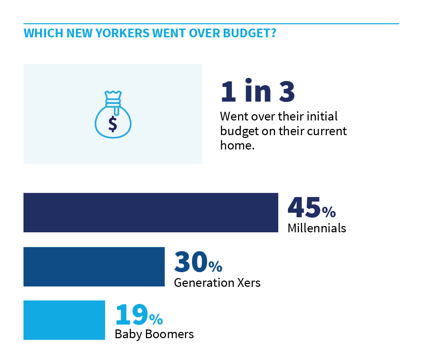
Affordability Is Relative
There is widespread perception of New York as a financially burdensome place to live. Forty-six percent of New Yorkers view the city overall as unaffordable, while just 22 percent say housing costs here are manageable. Renters are significantly more likely to rate the cost of the city negatively: More than half (52 percent) of them say New York City is unaffordable, compared to 39 percent of homeowners.
But these views change significantly as city residents consider their neighborhood and their own home. Just over one in four New Yorkers (26 percent) say their neighborhood is unaffordable, a sizeable decline from perceptions of the city overall. And just 16 percent of survey respondents rate their current home as unaffordable, with the vast majority saying they get by every month.
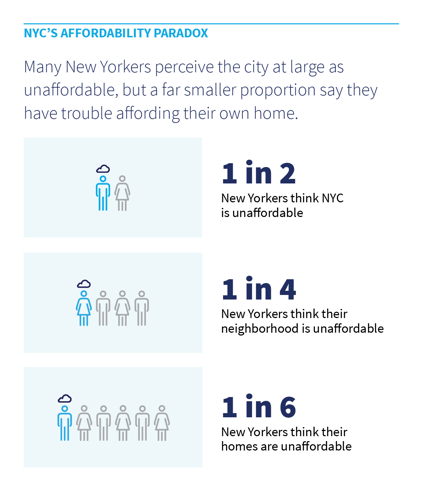
Renters are 1.2 times more likely to rate their homes as unaffordable: Unlike homeowners, whose largest monthly payments tend to be fixed to the rate on their mortgage, monthly rent has risen over time as the city’s economy has expanded. Only a small slice of renters — those benefiting from rent control, government subsidies, or generous landlords — are likely to have their rents remain flat while overall city rates increase.
But New Yorkers show a fundamental dissonance in the perception of New York housing costs: Residents are likely to classify the city and even their own neighborhood as unaffordable, even while they feel they can afford their New York home.
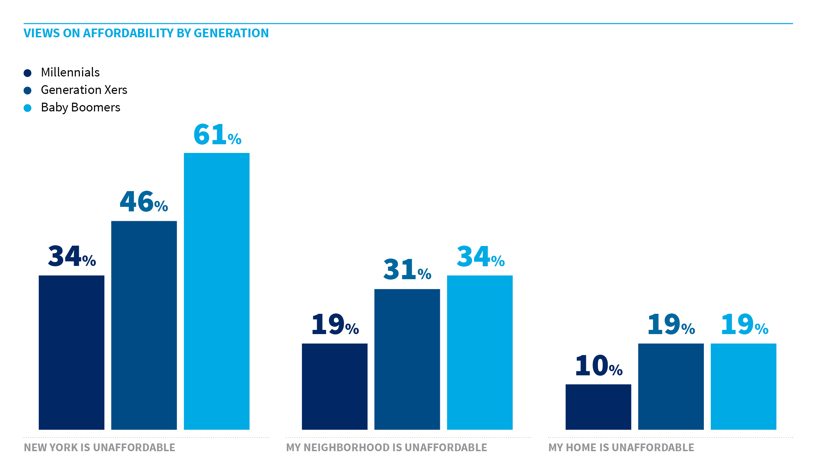
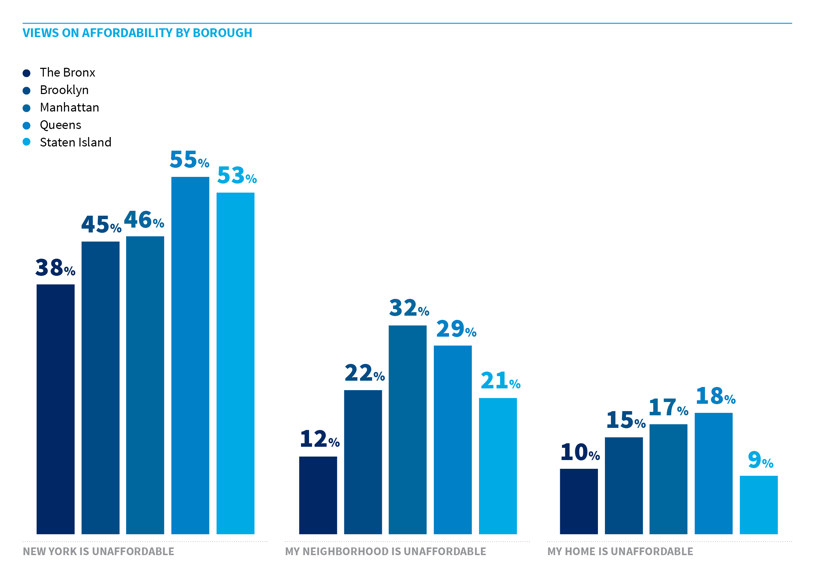
The High Cost of Homes on the Market Drives Negative Perceptions
Renters’ perception of living in an unaffordable city is likely driven in part by the high cost of homes on the market, as well as New Yorkers’ sense that they’re getting a good deal on their current home. A significant gap exists between rents advertised on the market through StreetEasy and the rents reported in the U.S. Census’ most recent American Community Survey.
In 2016, the median asking rent for a Manhattan apartment on StreetEasy was $3,193, more than twice the $1,488 the U.S. Census reports as the median rent paid by Manhattan households. Similar gaps exist in Brooklyn and Queens, indicating that many New Yorkers are paying far lower rents than current market prices suggest. Census numbers include publicly subsidized homes and a more complete share of units subject to rent control and rent stabilization than do StreetEasy listings. The scale of these differences, and the expensive nature of much of the inventory on the market, likely help fuel New Yorkers’ perceptions of an unaffordable city.
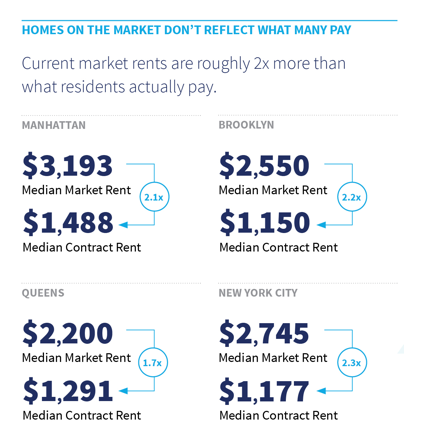
Unlike owners, whose housing costs are often relatively flat year to year, renters more directly bear the brunt of rising housing costs in the city. According to our survey, 64 percent of New Yorkers have faced a rent increase in the last three years, and 71 percent of renters have faced a price increase at their current home. Renters who live in bigger buildings have the potential to feel this most acutely: 76 percent of those living in buildings with 50 or more units have experienced a rent increase in the last three years, compared to 47 percent of those renting in small buildings, and 36 percent of those renting a single-family home or townhouse.
Indeed, for townhouses and single-family homes, which are more likely to be run by individual landlords as opposed to large management companies, rent increases are the exception: 61 percent of renters in these buildings have not experienced a price increase since moving in, compared to the only 18 percent of renters in large buildings who haven’t seen a price increase.
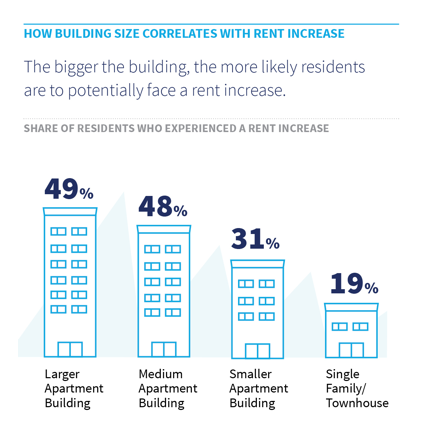
New Yorkers settled in their current homes — including homeowners and renters benefiting from rent control and stabilization — may need not concern themselves with the current market or rising prices. But our survey shows that a substantial share of the city’s population plans to face the housing market in the coming year.
New Yorkers Move in Search of Deals and Stability
Despite the rising cost of housing in the city, 59 percent of New Yorkers under the age of 45 say they plan to move in the next 12 months. Within this group, owners are just as likely as renters to plan to move in the next year, with roughly 59 percent considering a relocation before October 2018. Of renters under the age of 45 planning to move in the next year, more than half (54 percent) are considering or planning to purchase a home.
Millennials (ages 23-37) are most likely to consider buying a home in the next year, with more than a third hoping to do so, compared to just 11 percent of Generation Xers. One in four Generation Z residents (ages 18-22) are hoping to buy a home in the next year.
New Yorkers 45 and above are significantly more likely to stay put in the coming year, with 83 percent planning to remain in their current home. Only 9 percent of those over 45 plan to purchase a home in the coming year.
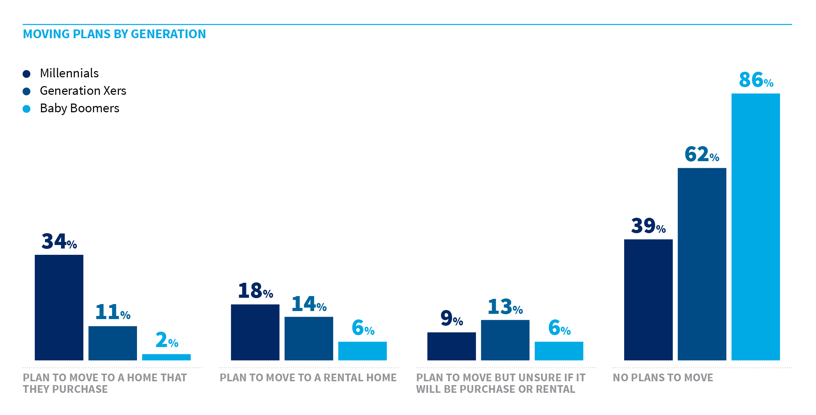
Though New Yorkers move often, they’re loyal to their boroughs. Of those planning to move in the next year, 71 percent are considering staying within their borough and 36 percent are considering options in their same neighborhood. Only 17 percent are considering options outside of the city.
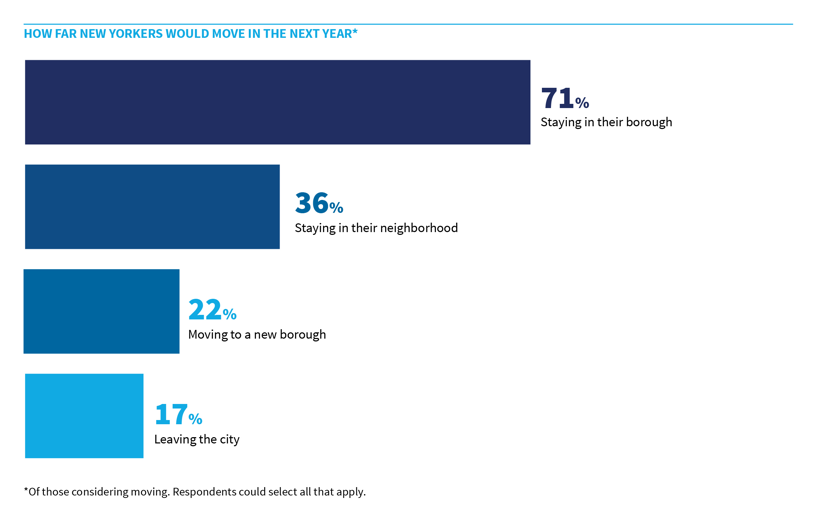
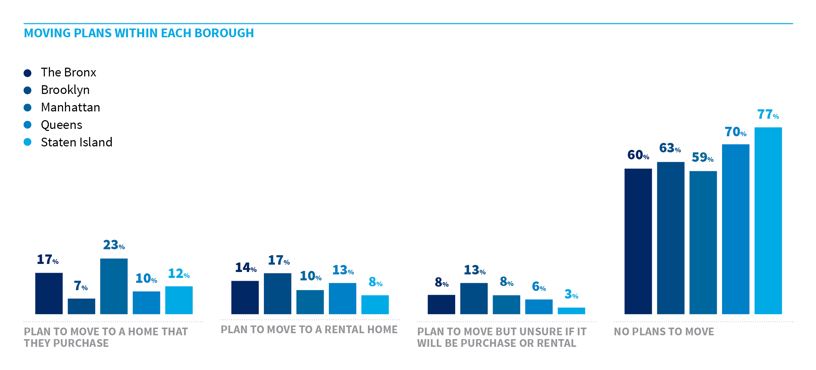
Cost Drives New Yorkers to Consider Leaving
Asked for the top factor that might lead them to leave the city, the largest share of New Yorkers (nearly a quarter) say they would seek a less expensive area. More than half cite cost as among the most important factors to consider when weighing a departure from New York. The ability to buy a home and the ability to live in a larger home are also among the most important factors New Yorkers would weigh when deciding to leave, with 54 percent ranking one of these as the top factor that might drive them away.
Though New Yorkers find the city hard to afford, the power of its economy remains a major draw. Survey respondents rank relocating for a job as among the least likely factors that might drive them to leave New York. Especially amid the current economic boom, residents are not eager to leave the city.
New Yorkers Love New York
Despite the high cost of housing, our survey found that many New Yorkers, whether renters or buyers, enjoy it here — more than half say they’d recommend living in the city to a friend. Having already made a significant investment in the city, homeowners recommend life in New York more consistently than renters, 65 percent to 52 percent. Younger residents are more enthusiastic, too: 67 percent of millennials recommend living here, compared to 52 percent of Generation Xers and 52 percent of baby boomers.
But New York is, of course, a city of neighborhoods, which is where residents’ greatest loyalties lie. Across nearly all breakdowns, New Yorkers are more willing to recommend their neighborhood than the city in general. Overall, 63 percent of New Yorkers, including 72 percent of owners and 56 percent of renters, would recommend their own neighborhood to a friend.
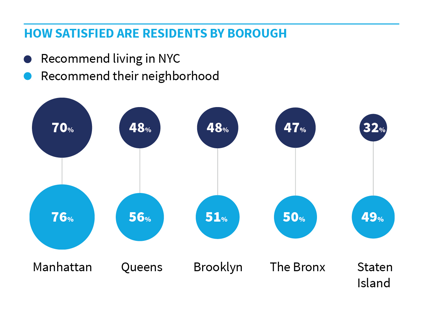
New Yorkers Want Safety, Transit and Fun in Their Neighborhoods
Affinity for both the city and one’s immediate neighborhood becomes evident when New Yorkers are asked how they chose where to live. Asked to rate which factors were required or desired of their current neighborhood, 90 percent cite safety as a requirement or desire, and 87 percent mention access to public transportation — a pattern that holds across both owners and renters. As one of the nation’s safest cities, and a place with one of the most extensive public transit networks in the world, New York has many neighborhoods that can satisfy these needs.
A neighborhood’s reputation and the availability of leisure activities also matter greatly to New Yorkers. Eighty-five percent of respondents cite a positive neighborhood reputation as a requirement or desire when searching for a home. The availability of leisure activities, such as shopping, dining, and nightlife, is similarly popular, with 83 percent of New Yorkers citing these amenities as required or desired.
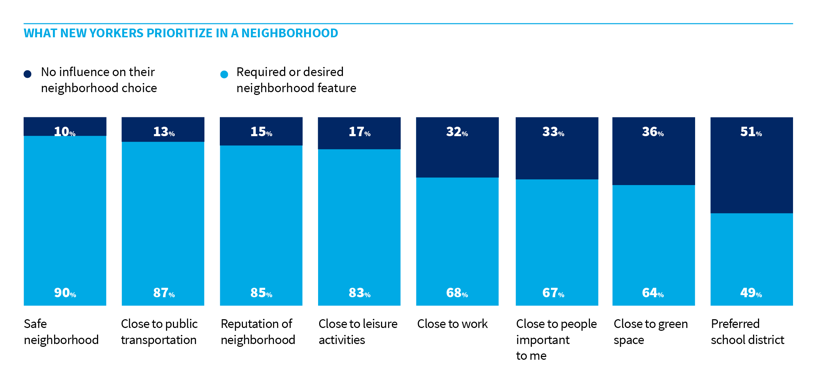
Schools and Green Space Are Less of a Draw
Factors less traditionally associated with life in New York City ranked lower as considerations. While 42 percent of New Yorkers cite green space as a desired feature of their neighborhood, another 36 percent said it did not factor into their consideration. Respondents are also least likely to rate green space as a requirement of all the neighborhood features, with only 22 percent doing so.
School districts factored into the decisions of less than half of New Yorkers, with many households without children presumably choosing to prioritize cost savings, and some households with children choosing private or magnet schools over their neighborhood zoned school. Of respondents with children, 76 percent require or desire a home in their preferred school district, while 23 percent said this had no impact on their neighborhood decision.
Finding Home in New York Means Making Tradeoffs
New Yorkers find themselves making tradeoffs in choosing a home, with most focusing on finding the right space at the right price above all else. When we asked New Yorkers to rate the importance of different factors in selecting a home, budget and preferred number of rooms ranked highest as requirements, with 66 percent and 55 percent of New Yorkers citing them, respectively. Total size, elevator, and storage space also ranked highly, with roughly 40 percent of New Yorkers citing each as a requirement.
Storage space and outdoor space ranked as the most desired though not required elements of a home, with around 40 percent of New Yorkers citing each as a desire. Recent renovations are also among the most desired attributes in homes, with 38 percent of New Yorkers citing them as nice but not essential. However, 40 percent of New Yorkers claimed to place no importance on whether a home has been recently renovated.
Though frequently found in New York apartment buildings, luxury amenities such as doormen and gyms are among the factors least considered by survey respondents. Fifty-four and 64 percent of New Yorkers cite a doorman and an in-building gym as factors that had no impact on their home decision, respectively. While these elements may help buildings differentiate themselves in small ways, New Yorkers are unlikely to sacrifice budget or space for the conveniences they afford.
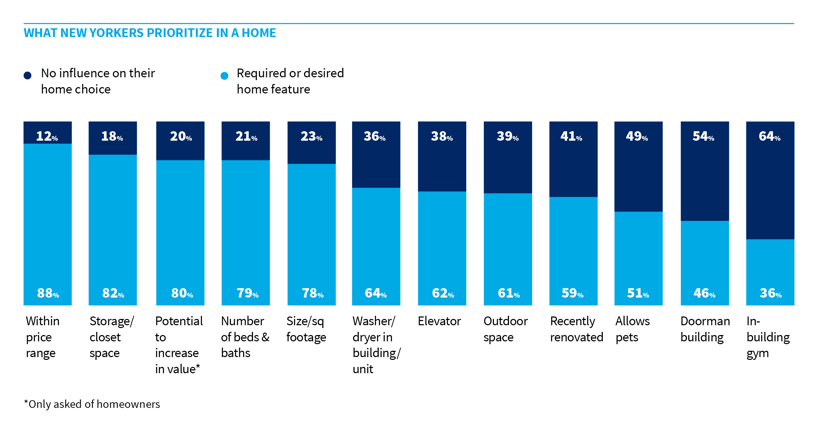
New York’s Success Depends on Affordability
New Yorkers received a small amount of relief from rising housing costs in 2017. Rents were largely flat across the city, and the pace of price increases in the sales market also moderated. For some New Yorkers, 2017 was a relatively good time to be a renter or buyer, with discounts and concessions rising across the five boroughs. However, 2017’s slowdown came after a sharp rise in housing costs during the years following the end of the last recession, and for a great many New Yorkers, making ends meet remains very difficult.
In the period since the Great Recession, New York City’s economy has not only outpaced growth of the national economy, but also substantially diversified into the technology and service-oriented roles now in high demand. New York continues to attract expansions from innovative, high-profile employers such as Google, Spotify, and Discovery Communications, to name a few. Employers expanding in New York City not only attract more highly educated, highly paid employees; research shows they also create additional lower-skilled jobs and push up wages across the earnings spectrum. In doing so, they expand the city’s tax base, providing funding to support the services — like public transportation and policing — upon which nearly all New Yorkers rely.
However, the greater the perception of New York as unaffordable, the larger the obstacles to the city’s future growth. In gauging the early contenders for Amazon’s second headquarters, some pundits discounted New York City’s chances of winning due to its high housing costs. Indeed, as our survey shows, affordability is the chief reason many New Yorkers would consider leaving the city. As a result, the city’s continued growth is dependent on demonstrating to current and future New Yorkers just how much there is to love in the city, and assuring them that they will be able to continue to reap the benefits of living in such a dynamic place for years to come.
Methodology
StreetEasy partnered with independent market research firm YouGov to conduct a representative, blind survey that was fielded online in November 2017. The survey gathered information from 1,000 key household decision-makers living in all five boroughs of New York City. Data was collected through a general market sampling of renters and homeowners, and quotas based on the U.S. Census were set for age, gender, and education. The data was then weighted to known U.S. Census estimates on age, gender, race and education to ensure respondents were representative of the New York City population. The results then underwent substantial internal analysis and review by researchers and economists at StreetEasy.
[1] Bureau of Economic Analysis, U.S. Chamber of Commerce.
[2] NYC Quarterly Economic Update, NYC Comptroller’s Office, Bureau of Budget, 2017.
[3] United States Census Bureau. 2012 – 2016 American Community Survey. U.S. Census Bureau’s American Community Survey Office, 2016.
[4] Ibid.
[5] Ibid.
